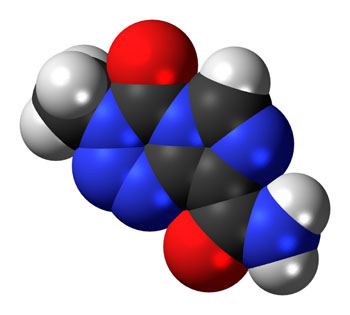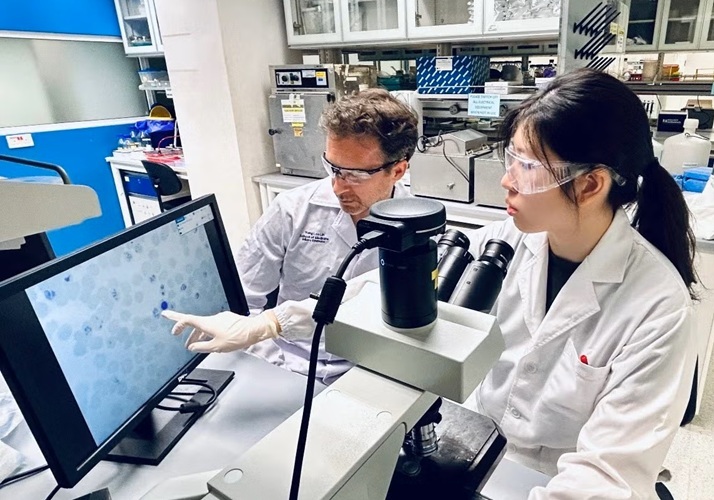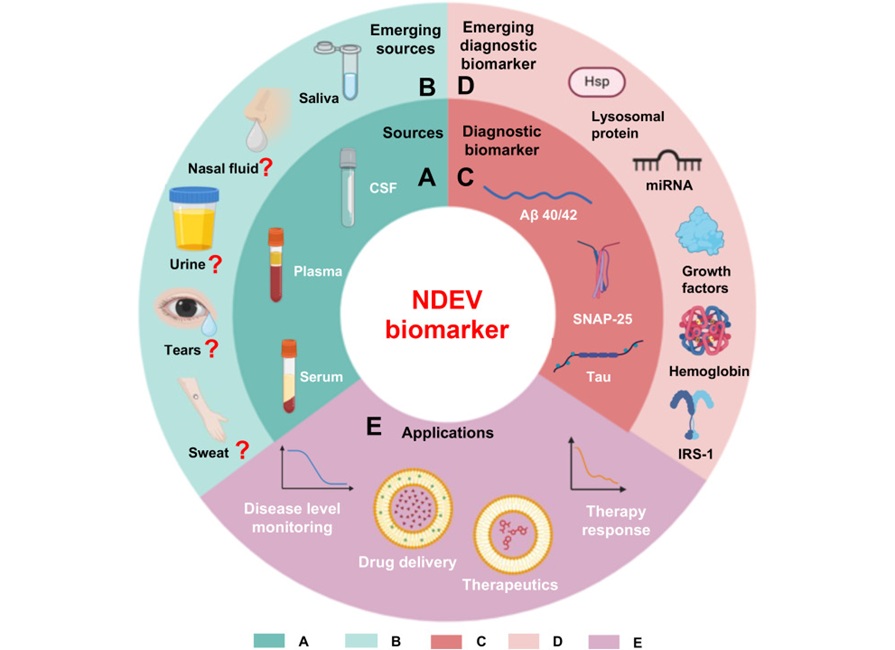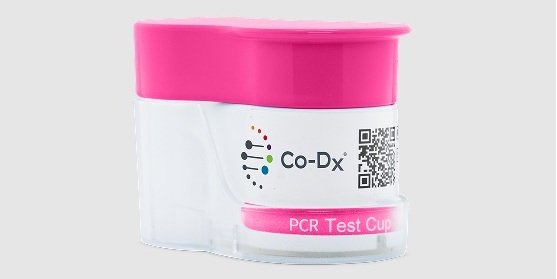Protein Identified That Boosts Brain Tumor Resistance to Chemotherapy
|
By LabMedica International staff writers Posted on 26 Jan 2016 |

Image: Space-filling model of the anticancer drug temozolomide (Photo courtesy of Wikimedia Commons).
Cancer researchers have linked development of resistance to the anticancer drug temozolomide by glioblastoma multiforme (GBM) brain cancer cells to the activity of the RhoG-specific guanine nucleotide exchange factor protein SGEF.
GBM is the highest grade and most common form of primary adult brain tumors. Despite surgical removal followed by concomitant radiation and chemotherapy with the alkylating agent temozolomide (TMZ), GBM tumors develop treatment resistance and ultimately recur. Impaired response to treatment occurs rapidly, conferring a median survival of just fifteen months. Thus, researchers are seeking to identify the genetic and signaling mechanisms that promote tumor resistance in order to develop targeted therapies to combat this refractory disease.
The therapeutic benefit of TMZ depends on its ability to alkylate/methylate DNA, which most often occurs at the N-7 or O-6 positions of guanine residues. This methylation damages the DNA and triggers the death of tumor cells. However, some tumor cells are able to repair this type of DNA damage, and therefore diminish the therapeutic efficacy of TMZ, by expressing the protein O6-alkylguanine DNA alkyltransferase (AGT) encoded in humans by the O-6-methylguanine-DNA methyltransferase (MGMT) gene. In some tumors, epigenetic silencing of the MGMT gene prevents the synthesis of this enzyme, and as a consequence such tumors are more sensitive to killing by TMZ. Conversely, the presence of AGT protein in brain tumors predicts poor response to TMZ and these patients receive little benefit from chemotherapy with this drug.
Previous studies have shown that SGEF (Src homology 3 domain-containing guanine nucleotide exchange factor) was overexpressed in GBM tumors and played a role in promoting TWEAK-Fn14–mediated glioma invasion. TWEAK is a multifunctional cytokine that controls many cellular activities including proliferation, migration, differentiation, apoptosis, angiogenesis, and inflammation. TWEAK acts by binding to Fn14, a highly inducible cell-surface receptor that is linked to several intracellular signaling pathways, including the nuclear factor-kappaB (NF-kappaB) pathway. The TWEAK–Fn14 axis normally regulates various physiological processes; in particular it seems to play an important, beneficial role in tissue repair following acute injury. Furthermore, recent studies have indicated that TWEAK–Fn14 axis signaling may contribute to cancer, chronic autoimmune diseases, and acute ischemic stroke.
Investigators at The Translational Genomics Research Institute (Phoenix, AZ, USA) reported in the January 13, 2016, online edition of the journal Molecular Cancer Research that SGEF expression was upregulated by TWEAK-Fn14 signaling via NF-kappaB activity while shRNA (short hairpin RNA)-mediated reduction of SGEF expression sensitized glioma cells to temozolomide-induced apoptosis and suppressed colony formation following temozolomide treatment.
Nuclear SGEF was activated following temozolomide exposure and formed complexes with the DNA damage repair protein BRCA1 (breast cancer 1), which enabled tumor cells to rapidly repair the damaged DNA that otherwise would lead to cell death. In contrast, BRCA1 phosphorylation in response to temozolomide treatment was hindered by inhibition of SGEF.
"We need to identify the genetic and cellular-pathway signaling mechanisms that make brain tumors resistant to treatment," said senior author Dr. Nhan Tran, head of the central nervous system tumor research laboratory at The Translational Genomics Research Institute. "And the role of SGEF in promoting chemotherapeutic resistance highlights this previously unappreciated protein. Importantly, this also suggests that SGEF could be a new candidate for development of targeted therapeutics."
Related Links:
The Translational Genomics Research Institute
GBM is the highest grade and most common form of primary adult brain tumors. Despite surgical removal followed by concomitant radiation and chemotherapy with the alkylating agent temozolomide (TMZ), GBM tumors develop treatment resistance and ultimately recur. Impaired response to treatment occurs rapidly, conferring a median survival of just fifteen months. Thus, researchers are seeking to identify the genetic and signaling mechanisms that promote tumor resistance in order to develop targeted therapies to combat this refractory disease.
The therapeutic benefit of TMZ depends on its ability to alkylate/methylate DNA, which most often occurs at the N-7 or O-6 positions of guanine residues. This methylation damages the DNA and triggers the death of tumor cells. However, some tumor cells are able to repair this type of DNA damage, and therefore diminish the therapeutic efficacy of TMZ, by expressing the protein O6-alkylguanine DNA alkyltransferase (AGT) encoded in humans by the O-6-methylguanine-DNA methyltransferase (MGMT) gene. In some tumors, epigenetic silencing of the MGMT gene prevents the synthesis of this enzyme, and as a consequence such tumors are more sensitive to killing by TMZ. Conversely, the presence of AGT protein in brain tumors predicts poor response to TMZ and these patients receive little benefit from chemotherapy with this drug.
Previous studies have shown that SGEF (Src homology 3 domain-containing guanine nucleotide exchange factor) was overexpressed in GBM tumors and played a role in promoting TWEAK-Fn14–mediated glioma invasion. TWEAK is a multifunctional cytokine that controls many cellular activities including proliferation, migration, differentiation, apoptosis, angiogenesis, and inflammation. TWEAK acts by binding to Fn14, a highly inducible cell-surface receptor that is linked to several intracellular signaling pathways, including the nuclear factor-kappaB (NF-kappaB) pathway. The TWEAK–Fn14 axis normally regulates various physiological processes; in particular it seems to play an important, beneficial role in tissue repair following acute injury. Furthermore, recent studies have indicated that TWEAK–Fn14 axis signaling may contribute to cancer, chronic autoimmune diseases, and acute ischemic stroke.
Investigators at The Translational Genomics Research Institute (Phoenix, AZ, USA) reported in the January 13, 2016, online edition of the journal Molecular Cancer Research that SGEF expression was upregulated by TWEAK-Fn14 signaling via NF-kappaB activity while shRNA (short hairpin RNA)-mediated reduction of SGEF expression sensitized glioma cells to temozolomide-induced apoptosis and suppressed colony formation following temozolomide treatment.
Nuclear SGEF was activated following temozolomide exposure and formed complexes with the DNA damage repair protein BRCA1 (breast cancer 1), which enabled tumor cells to rapidly repair the damaged DNA that otherwise would lead to cell death. In contrast, BRCA1 phosphorylation in response to temozolomide treatment was hindered by inhibition of SGEF.
"We need to identify the genetic and cellular-pathway signaling mechanisms that make brain tumors resistant to treatment," said senior author Dr. Nhan Tran, head of the central nervous system tumor research laboratory at The Translational Genomics Research Institute. "And the role of SGEF in promoting chemotherapeutic resistance highlights this previously unappreciated protein. Importantly, this also suggests that SGEF could be a new candidate for development of targeted therapeutics."
Related Links:
The Translational Genomics Research Institute
Latest BioResearch News
- Genome Analysis Predicts Likelihood of Neurodisability in Oxygen-Deprived Newborns
- Gene Panel Predicts Disease Progession for Patients with B-cell Lymphoma
- New Method Simplifies Preparation of Tumor Genomic DNA Libraries
- New Tool Developed for Diagnosis of Chronic HBV Infection
- Panel of Genetic Loci Accurately Predicts Risk of Developing Gout
- Disrupted TGFB Signaling Linked to Increased Cancer-Related Bacteria
- Gene Fusion Protein Proposed as Prostate Cancer Biomarker
- NIV Test to Diagnose and Monitor Vascular Complications in Diabetes
- Semen Exosome MicroRNA Proves Biomarker for Prostate Cancer
- Genetic Loci Link Plasma Lipid Levels to CVD Risk
- Newly Identified Gene Network Aids in Early Diagnosis of Autism Spectrum Disorder
- Link Confirmed between Living in Poverty and Developing Diseases
- Genomic Study Identifies Kidney Disease Loci in Type I Diabetes Patients
- Liquid Biopsy More Effective for Analyzing Tumor Drug Resistance Mutations
- New Liquid Biopsy Assay Reveals Host-Pathogen Interactions
- Method Developed for Enriching Trophoblast Population in Samples
Channels
Clinical Chemistry
view channel
Compact Raman Imaging System Detects Subtle Tumor Signals
Accurate cancer diagnosis often depends on labor-intensive tissue staining and expert pathological review, which can delay results and limit access to rapid screening. These conventional methods also make... Read more
Noninvasive Blood-Glucose Monitoring to Replace Finger Pricks for Diabetics
People with diabetes often need to measure their blood glucose multiple times a day, most commonly through finger-prick blood tests or implanted sensors. These methods can be painful, inconvenient, and... Read moreMolecular Diagnostics
view channel
Blood Test Could Identify Biomarker Signature of Cerebral Malaria
Malaria remains a major cause of death and long-term disability in many low- and middle-income countries, with around 600,000 deaths reported globally each year. The most severe form, cerebral malaria,... Read more
World’s First Biomarker Blood Test to Assess MS Progression
Multiple sclerosis (MS) disease activity is caused by an abnormal immune response that results in damage to the brain and spinal cord. However, there is a lack of reliable tools to measure or predict MS progression.... Read moreHematology
view channel
MRD Tests Could Predict Survival in Leukemia Patients
Acute myeloid leukemia is an aggressive blood cancer that disrupts normal blood cell production and often relapses even after intensive treatment. Clinicians currently lack early, reliable markers to predict... Read more
Platelet Activity Blood Test in Middle Age Could Identify Early Alzheimer’s Risk
Early detection of Alzheimer’s disease remains one of the biggest unmet needs in neurology, particularly because the biological changes underlying the disorder begin decades before memory symptoms appear.... Read more
Microvesicles Measurement Could Detect Vascular Injury in Sickle Cell Disease Patients
Assessing disease severity in sickle cell disease (SCD) remains challenging, especially when trying to predict hemolysis, vascular injury, and risk of complications such as vaso-occlusive crises.... Read more
ADLM’s New Coagulation Testing Guidance to Improve Care for Patients on Blood Thinners
Direct oral anticoagulants (DOACs) are one of the most common types of blood thinners. Patients take them to prevent a host of complications that could arise from blood clotting, including stroke, deep... Read moreImmunology
view channel
Ultrasensitive Liquid Biopsy Demonstrates Efficacy in Predicting Immunotherapy Response
Immunotherapy has transformed cancer treatment, but only a small proportion of patients experience lasting benefit, with response rates often remaining between 10% and 20%. Clinicians currently lack reliable... Read more
Blood Test Could Identify Colon Cancer Patients to Benefit from NSAIDs
Colon cancer remains a major cause of cancer-related illness, with many patients facing relapse even after surgery and chemotherapy. Up to 40% of people with stage III disease experience recurrence, highlighting... Read moreMicrobiology
view channel
New UTI Diagnosis Method Delivers Antibiotic Resistance Results 24 Hours Earlier
Urinary tract infections affect around 152 million people every year, making them one of the most common bacterial infections worldwide. In routine medical practice, diagnosis often relies on rapid urine... Read more
Breakthroughs in Microbial Analysis to Enhance Disease Prediction
Microorganisms shape human health, ecosystems, and the planet’s climate, yet identifying them and understanding how they are related remains a major scientific challenge. Even with modern DNA sequencing,... Read morePathology
view channel
Genetics and AI Improve Diagnosis of Aortic Stenosis
Aortic stenosis is a progressive narrowing of the aortic valve that restricts blood flow from the heart and can be fatal if left untreated. There are currently no medical therapies that can prevent or... Read more
AI Tool Simultaneously Identifies Genetic Mutations and Disease Type
Interpreting genetic test results remains a major challenge in modern medicine, particularly for rare and complex diseases. While existing tools can indicate whether a genetic mutation is harmful, they... Read more
Rapid Low-Cost Tests Can Prevent Child Deaths from Contaminated Medicinal Syrups
Medicinal syrups contaminated with toxic chemicals have caused the deaths of hundreds of children worldwide, exposing a critical gap in how these products are tested before reaching patients.... Read more
Tumor Signals in Saliva and Blood Enable Non-Invasive Monitoring of Head and Neck Cancer
Head and neck cancers are among the most aggressive malignancies worldwide, with nearly 900,000 new cases diagnosed each year. Monitoring these cancers for recurrence or relapse typically relies on tissue... Read moreTechnology
view channel
AI Predicts Colorectal Cancer Survival Using Clinical and Molecular Features
Colorectal cancer is one of the most common and deadly cancers worldwide, and accurately predicting patient survival remains a major clinical challenge. Traditional prognostic tools often rely on either... Read more
Diagnostic Chip Monitors Chemotherapy Effectiveness for Brain Cancer
Glioblastoma is one of the most aggressive and fatal brain cancers, with most patients surviving less than two years after diagnosis. Treatment is particularly challenging because the tumor infiltrates... Read moreIndustry
view channel
BD and Penn Institute Collaborate to Advance Immunotherapy through Flow Cytometry
BD (Becton, Dickinson and Company, Franklin Lakes, NJ, USA) has entered into a strategic collaboration with the Institute for Immunology and Immune Health (I3H, Philadelphia, PA, USA) at the University... Read more







 assay.jpg)













